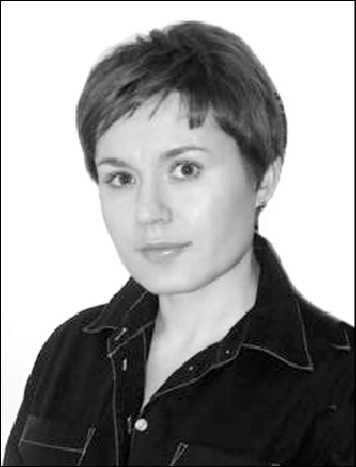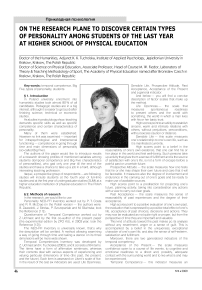On the research plane to discover certain types of personality among students of the last year at higher school of physical education
Автор: Tucholska K.K., Fiedor M.W.
Журнал: Физическая культура, спорт - наука и практика @fizicheskaya-kultura-sport
Рубрика: Прикладная психология
Статья в выпуске: 4, 2008 года.
Бесплатный доступ
Temporal competence, big five, types of personality, students
Короткий адрес: https://sciup.org/14263518
IDR: 14263518
Текст статьи On the research plane to discover certain types of personality among students of the last year at higher school of physical education
§ 1. Introduction
In Poland university enrolment into humanistic studies took almost 80 % of all candidates. Pedagogic studies are in a big interest, although it is easier to get a job after finishing science, technical or economic studies.
As studies in pedeutology show, teaching demands specific skills as well as specific competence and certain characteristics of personality.
Many of them were established.
However no link was examined — important for intrapsychological and interpersonal functioning — competence in going through time and main dimensions of personality (so-called Big Five).

The authors of the paper would like to introduce results of a research showing profiles of mentioned variables among students (temporal competence and Big Five characteristics of personalities), who gad only one year till the end of the studies and have a chance to take up a job in a hard, although interesting teaching profession.
Itaque, a prospective group of respondents —are following: studies will include students at the fourth year of full-time studies and at the first year of undergraduate studies (SUM) at a higher education institution of physical education in The Polish Republic.
§ 2. Methods of research
In the research, we would like to use:
Personality NEO-FFI Inventory worked out by P. T. Costa and R. R. McCrae (in the Polish version — the authors were: B. Zawadzki, J. Strelau, P. Szczepaniak and M. Sliwinska; look the Reference [11]).
Questionnaire of Temporal Competence worked out by Z. Uchnast and by the first co-author of the present paper (the experimental edition by ZPO KUL in 2003 year; look the Reference [12]).
The NEO-FFI Inventory is universally known, that’s why the description will be omitted. A method allowing examining a way of going through time and taking a stance on its three dimensions will be more wide shown.
Temporal Competencies Inventory was developed by Z. Uchnast and K. Tucholska (2003); and it consists of 64 items. The items have a form of affirmative sentences, whereas their contents deal with various aspects of experiencing and valuing particular dimensions of time (the past, the present, and the future). Each item is assessed on Likert’s scale of five. In the result of the test six indicators are used: Life Openness,
Sensible Life, Prospective Attitude, Past Acceptance, Acceptance of the Present and a general indicator.
And below — you will find a concise description of factor scales that make up the method.
Life Openness — the scale that measures spontaneous readiness to present others and the world with something, the world in which a man lives with his or her basic trust.
High scores point to an ability to establish sincere, warm and intimate relations with others, without prejudices, preconditions, without excess caution or distance.
Sensible Life — this scale measures one’s relationship to one’s own life, such as it is manifested currently.
High scores point to a belief in the reasonability of one’s own existence, that one can find his or her place in the world and feel well-being. Such persons take up activity that gives them a sense of fulfillment and is the source of satisfaction with one’s life, is not a form of escape before a painful past or uncertain future.
Prospective Attitude — the scale measures how one feels that he or she may shape their own future and care that it will be favorable. It measures also the degree of involvement and endurance in the carrying out of one’s goals and be ready to make use of available sources.
High scores point to a predilection for projecting one’s future, planning activity, taking into consideration any actions with a view to carry out clear goals.
Past Acceptance — the scale measures the sense of reasonability of past experiences and the degree of their acceptance.
High scores point to a positive evaluation of one’s own past, the evaluation that is expressed by a positive total effect of one’s life, acceptance of past choices, decisions and actions. They may now be evaluated as not quite right or proper, but from the perspective of time they are important and valuable.
This kind of attitude toward the past makes pc its analysis without any resentment, anger or a sense of guilt. This is accompanied by a belief in the uniqueness, exceptional character of one’s own life, and also the sense of self-esteem, satisfaction and fulfillment.
Moreover, there are two generalized indicators of the temporal competency:
Acceptance of the Present — the scale measures confidence open to a course of life events, to cognitive and emotional readiness to a direct and, possibly, adequate contact with the surrounding world and to live what is and may be experienced.
Temporal Competence — this indicator measures an adequate functioning and development of man, such that is conditioned by an ability to simultaneously ‘move’ across the three dimensions of time in concrete tasks one has in life. This ability is grounded in one’s knowledge about one’s past, present and future. It is expressed by an adequate use of those sources in coping with a concrete situation ‘here and now.’ The high score of Temporal Competence means that one is, respectively, capable of recognizing challenges and requirements in life. One may also adequately cope with them ‘here and now’ and/or in the future with respect to his or her experience from the past and/or activities with a view to the anticipated future.
§ 3. Some Remarks
Itaque, a typology of prospective researches will be based on results of a whole group in factors measured with the NEO-FFI Inventory by P. T. Costa and R. R. McCrae and Questionnaire of Temporal Competence by Z. Uchnast and K. Tucholska.
Use of the analysis of the data will be conducted with a method of neuron network that allows to distinguish, as far as it is able, four types of groups of students because of their results in the above mentioned methods. Thus, in a group of examined students, four homogeneous groups will be singled out because of a level and structure of personality variables and temporal competence. We plan basic descriptions of the types to be presented in our next publication.
The results of the blinkered variational analysis (the results of the MANOVA analysis) that will be carried out during our research should be introduced in a table of comparison of the types in the scope of results in the scales NEO-FFI and Questionnaire of Temporal Competence. Average results in the scales NEO-FFI and Questionnaire of Temporal Competence of the above mentioned types — will be demonstrated in a diagram.
Obtained data would allow to identify specific constellation of personality dimensions measured with the NEO-FFI and Questionnaire of Temporal Competence.
Previously, we assume that a way of experiencing time and disposal to its three dimensions, stay in a close relation to a way of functioning of people at different levels.
It seems — a perspective of another tests with the same group of young people after beginning a job in a teaching profession would be interesting.
Acknowledgements
The co-authors of this paper intimately acknowledge the moral support and sincere interest to their researches by Prof. I. V. Kochubey (The Russian Federation).


